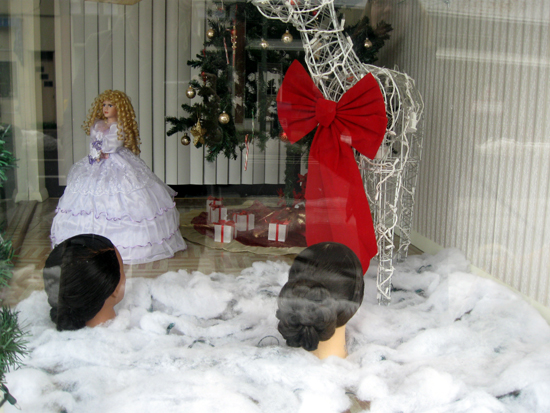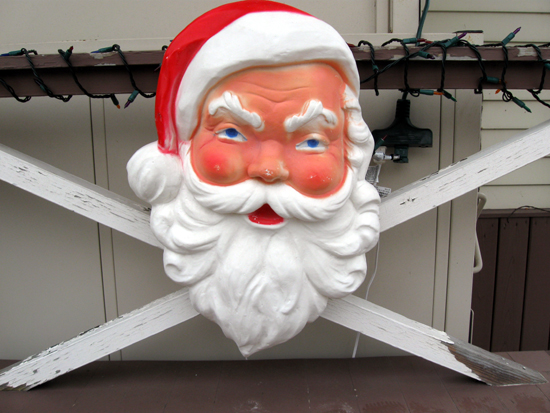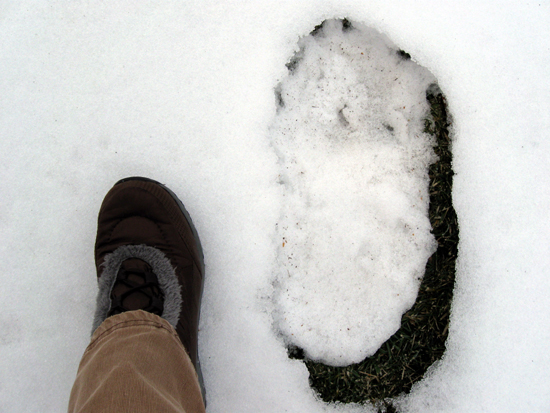In addition, I ran a few errands with The Gryphon: getting
an adapter from the Verizon store so that I can charge my recently purchased
phone, buying a camera bag and rechargeable batteries from Staples;
got some anti-itch cream for Una from the pet store; and picked up shampoo
and conditioner from the drug store.
We ate lunch at a little lunch counter located in a furniture
outlet, which happens to be right next to a farm. Still, we didn't expect
to be greeted by a very friendly turkey, who appeared to be begging
from us. The turkey was adorable, making cute little sounds. It seemed
to really like The Gryphon.

(Faster-loading
version)

(faster-loading
version)
Of course, when we looked at the menu and I noticed most
of the sandwiches had turkey, I ordered a vegetarian wrap instead!
For dinner, my sister's husband made a really mean chili.
He made two batches: one milder for my Mom, who can't handle spicy food.
We served it with miniature corn muffins, provided by Mom, and a salad
I made up from the ingredients Dad had purchased earlier. My sister
and her husband also contributed a bottle of red wine they'd brought.
That evening, we watched The Pursuit of Happyness,
which is a Will Smith movie I'd brought with me. Everyone seemed to
like it and were very interested in also watching the interview with
the real Chris Gardner that came with the movie.
On Saturday, Dad was the only one who had to work. My sister,
was anxious to get out of the house, so she and I took a morning walk
with the dogs. I took my camera with me, because I wanted to get a photo
of a shop window I'd seen the previous evening. A hair stylist, who
apparently wanted to both show off her up-dos and celebrate the season,
found a strange compromise, with disembodied heads floating in a sea
of fake snow.

(Faster-loading
version)

(faster-loading
version)
We drove, then, to my Mom's house to discuss what to do
the rest of the day. She was busy that afternoon, but we called one
of her favorite restaurants to make dinner reservations, a converted
railroad stations. You see a number of them in Central Pennsylvania:
railroad stations converted into restaurants, businesses, or municipal
offices.
My sister wanted to drive to the local mall to return a
shirt she'd bought for her husband for Christmas. He roots for the Washington
Redskins, his hometown team, and she'd bought him a T-shirt with the
old logo (which predates the Native American caricature). But the store
clerk had neglected to remove the security tag, and when she tried to
remove it herself, she damaged the shirt. So we called first to make
sure the mall had a Champ's.
On the way, we utilized my sister's big Christmas gift from
Dad: a
Garmin Nuvi, or GPS navigator. If you input an address, it will
give you directions to get there. We were completely entertained by
the system, which became a running joke. When we were walking somewhere
later, someone would say, in a computerized voice, "Turn left in
ten feet." Or we'd give other, more malicious computerized commands,
as if the computer had gone insane, HAL 900 style: "Go jump in
the river in 50 feet."
The mall was surprisingly crowded, probably from people
making exchanges or using gift cards, as well as scouting out sales.
It's always interesting to go to a mall in rural Pennsylvania after
shopping in, say, New York or Philadelphia. You see a lot more baseball
caps. And camo.
For lunch, we had coffee and sandwiches at a little coffee
shop, then returned the shirt. The manager at Champs was very helpful,
and although they didn't sell Washington Redskins gear (this was Pittsburgh
Steelers territory), my sister's husband exchanged the shirt for a very
nice Penn State hooded sweatshirt. The manager advised my sister to
call the customer service number anyway, to inform them about the mistake
so that the original store could be notified and avoid making similar
mistakes in the future.
While the men checked out the bookstore, my sister and I
shopped for dress boots for her at Payless and then at the Burlington
Coat Factory. We didn't find anything suitable, but we did find some
absolutely hideous hightops. And yes, they were in the adult women's
section, not the little girls' section. I can almost hear someone arguing
to Clinton and Stacy of TLC's
What Not to Wear: "They're dress shoes. See, they're
shiny!"
This photo, by the way, is taken with my cell phone camera,
the V Cast Messaging Phone by LG. It gets much better pics than my previous
cell phone.

(Faster-loading
version)
The only thing I purchased while at the mall was a new set
of snow booties for Una, whose feet are really sensitive to ice and
rock salt. Back at Dad's place, I tried them on. They seem like they
might stay on a little better than the previous set I used.

(Faster-loading
version)
After I took a nap, Dad helped me to walk the two dogs.
We returned just in time to get ready and then meet Mom for dinner at
the restaurant. Mom beat us there and had already ordered herself soup
when we arrived. Instead of a bread basket, the restaurant offered a
little container of crackers, bread sticks and two different types of
cheese spread. It was a nice idea, even though the cheese was commercially
made and a bit salty.
I ordered a tuna steak, medium rare. It was overdone and
fairly bland, but at least it was a fairly healthy dinner. Afterwards,
we all ordered desserts to share. That part might not have been as healthy,
I'll admit.
We had talked about seeing a movie, but we'd missed the
7 p.m. showings, so we played a board game instead. This was the game
The Gryphon and I gave Dad for Christmas, since the company, Kvale
Good Natured Games, supports environmental causes. The game is designed
to increase environmental awareness and is called Bioviva.
At the beginning of the game, as we were still reading the
rules, I tried a few shots using the timer on my new camera. I didn't
have the settings quite right and after fiddling with it a few times,
I quit. That's something I'll have to experiment with again, after reading
the book.

(Faster-loading
version)

(faster-loading
version)
Bioviva is an environmental trivia game. Players move their
markers around a map showing the different environmental regions, such
as tundra and temperate forest. Their goal is to answer enough questions
to earn 12 eco-points and thus win the game. Those points are acquired
by landing on the squares that apply to the appropriate environmental
regions which each player needs to acquire. Then, the player needs to
answer a multiple-choice question correctly. Each person has a different
combination of 12 eco-points to seek, based on cards drawn randomly
at the beginning of the game. Each round, all players offer their answers
to the same question, and then those who get it right have an opportunity
to earn eco-points.
However, winning eco-points is not a guarantee, even if
you answer the question correctly. Rather, it depends on drawing another
card, which tells you what action to take. Sometimes, in fact, you lose
eco-points. We found this aspect of the game to be very frustrating,
especially when it happened multiple times in a row. We believed this
was bad game design: that players could be punished for answering questions
correctly.
Clearly, the action cards were an effort to extend game
play and make it more exciting. But we felt the cards should be drawn
at a different stage in the round, so that it's not directly connected
to answering the question right. Maybe everyone could receive eco-points
for receiving a correct answer, and the action card would be drawn afterwards.
Another flaw in the game design was the reliance on colors
to indicate important information. The cards are double-sided, which
of course, saves paper. However, the colors of the two sides are a grayish
red and a grayish green, which colorblind people would find indistinguishable.
It would have been better if, in addition to being a different color,
the two sides were also marked with different symbols.
In the same way, the markers used to indicate eco-points
collected include a number of shades of red and green, all at a similar
saturation level. This again poses a problem for those who are color
blind. It would have been better if each of the markers also contained
letters, indicating the environmental zones.
The zones on the board were often marked with the name of
the zone, but in some of the smaller sections, they were not marked.
This could have been addressed by including different background patterns:
say hash marks or stripes or dots, so that they would still be easily
distinguished, should anyone have difficulty identifying the colors.
We did like several aspects of the game. In particular,
we found the questions to be challenging and interesting. We also liked
the movement around the board, which is controlled by rolling a die
and then moving in one direction. But the game doesn't offer much interactivity
between players, so many game aficionados would become easily bored.
We didn't realize, until The Gryphon looked it up online,
that the game was developed in 1996. This would explain why the box
bragged about awards received in 1998 and 2000. It certainly might be
time for an update, and if they do update the game, they should consider
revisiting some aspects of it.
Still, we agreed that we would play the game again, although
we might institute some of our own home rules to improve the enjoyment.
Sunday was our last day. We spent a quiet morning, waking
up gradually. Then my sister, her husband and I returned some items
to Mom. She wasn't home, since she was helping with a few things at
the church, so we stopped by to tell her good-bye. Mom hugged us all
and told us how much she'd appreciated seeing us over the holidays.
Then we packed up and headed home. Much as it had on the
way there, the skies opened up with rain.

















